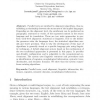Free Online Productivity Tools
i2Speak
i2Symbol
i2OCR
iTex2Img
iWeb2Print
iWeb2Shot
i2Type
iPdf2Split
iPdf2Merge
i2Bopomofo
i2Arabic
i2Style
i2Image
i2PDF
iLatex2Rtf
Sci2ools
132
Voted
CIARP
2009
Springer
2009
Springer
Incorporating Linguistic Information to Statistical Word-Level Alignment
Abstract. Parallel texts are enriched by alignment algorithms, thus establishing a relationship between the structures of the implied languages. Depending on the alignment level, the enrichment can be performed on paragraphs, sentences or words, of the expressed content in the source language and its translation. There are two main approaches to perform word-level alignment: statistical or linguistic. Due to the dissimilar grammar rules the languages have, the statistical algorithms usually give lower precision. That is why the development of this type of algorithms is generally aimed at a specific language pair using linguistic techniques. A hybrid alignment system based on the combination of the two traditional approaches is presented in this paper. It provides user-friendly configuration and is adaptable to the computational environment. The system uses linguistic resources and procedures such as identification of cognates, morphological information, syntactic trees, dictionaries, a...
Related Content
| Added | 16 Feb 2011 |
| Updated | 16 Feb 2011 |
| Type | Journal |
| Year | 2009 |
| Where | CIARP |
| Authors | Eduardo Cendejas, Grettel Barceló, Alexander F. Gelbukh, Grigori Sidorov |
Comments (0)

